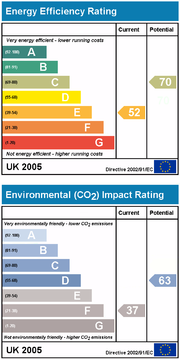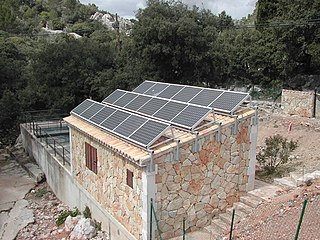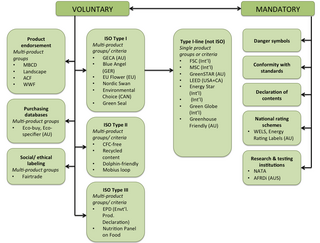
An energy performance certificate (EPC) is a rating scheme to summarise the energy efficiency of buildings or devices. [1] [2]

An energy performance certificate (EPC) is a rating scheme to summarise the energy efficiency of buildings or devices. [1] [2]
In the European Union, EPCs are regulated by Energy Performance of Buildings Directive 2010.
EPCs are mandatory when buying or selling property. [3]
Energy performance certificates (EPCs) are a rating scheme to summarise the energy efficiency of buildings. [4] [5] The building is given a rating between A (Very efficient) - G (Inefficient). The EPC will also include tips about the most cost-effective ways to improve the home energy rating. Energy performance certificates are used in many countries.
Energy Star (trademarked ENERGY STAR) is a program run by the U.S. Environmental Protection Agency (EPA) and U.S. Department of Energy (DOE) that promotes energy efficiency. [6] The program provides information on the energy consumption of products and devices using different standardized methods. The Energy Star label [7] is found on more than 75 different certified product categories, homes, commercial buildings, and industrial plants. In the United States, the Energy Star label is also shown on the Energy Guide appliance label of qualifying products.

Energy Star is a program run by the U.S. Environmental Protection Agency (EPA) and U.S. Department of Energy (DOE) that promotes energy efficiency. The program provides information on the energy consumption of products and devices using different standardized methods. The Energy Star label is found on more than 75 different certified product categories, homes, commercial buildings, and industrial plants. In the United States, the Energy Star label is also shown on the Energy Guide appliance label of qualifying products.

Environment friendly processes, or environmental-friendly processes, are sustainability and marketing terms referring to goods and services, laws, guidelines and policies that claim reduced, minimal, or no harm upon ecosystems or the environment.

EU Directive 92/75/EC (1992) established an energy consumption labelling scheme. The directive was implemented by several other directives thus most white goods, light bulb packaging and cars must have an EU Energy Label clearly displayed when offered for sale or rent. The energy efficiency of the appliance is rated in terms of a set of energy efficiency classes from A to G on the label, A being the most energy efficient, G the least efficient. The labels also give other useful information to the customer as they choose between various models. The information should also be given in catalogues and included by internet retailers on their websites.

Ecolabels and Green Stickers are labeling systems for food and consumer products. The use of ecolabels is voluntary, whereas green stickers are mandated by law; for example, in North America major appliances and automobiles use Energy Star. They are a form of sustainability measurement directed at consumers, intended to make it easy to take environmental concerns into account when shopping. Some labels quantify pollution or energy consumption by way of index scores or units of measurement, while others assert compliance with a set of practices or minimum requirements for sustainability or reduction of harm to the environment. Many ecolabels are focused on minimising the negative ecological impacts of primary production or resource extraction in a given sector or commodity through a set of good practices that are captured in a sustainability standard. Through a verification process, usually referred to as "certification", a farm, forest, fishery, or mine can show that it complies with a standard and earn the right to sell its products as certified through the supply chain, often resulting in a consumer-facing ecolabel.

A low-energy house is characterized by an energy-efficient design and technical features which enable it to provide high living standards and comfort with low energy consumption and carbon emissions. Traditional heating and active cooling systems are absent, or their use is secondary. Low-energy buildings may be viewed as examples of sustainable architecture. Low-energy houses often have active and passive solar building design and components, which reduce the house's energy consumption and minimally impact the resident's lifestyle. Throughout the world, companies and non-profit organizations provide guidelines and issue certifications to guarantee the energy performance of buildings and their processes and materials. Certifications include passive house, BBC—Bâtiment Basse Consommation—Effinergie (France), zero-carbon house (UK), and Minergie (Switzerland).
Domestic housing in the United Kingdom presents a possible opportunity for achieving the 20% overall cut in UK greenhouse gas emissions targeted by the Government for 2010. However, the process of achieving that drop is proving problematic given the very wide range of age and condition of the UK housing stock.

The energy policy of the European Union focuses on energy security, sustainability, and integrating the energy markets of member states. An increasingly important part of it is climate policy. A key energy policy adopted in 2009 is the 20/20/20 objectives, binding for all EU Member States. The target involved increasing the share of renewable energy in its final energy use to 20%, reduce greenhouse gases by 20% and increase energy efficiency by 20%. After this target was met, new targets for 2030 were set at a 55% reduction of greenhouse gas emissions by 2030 as part of the European Green Deal. After the Russian invasion of Ukraine, the EU's energy policy turned more towards energy security in their REPowerEU policy package, which boosts both renewable deployment and fossil fuel infrastructure for alternative suppliers.

Energy performance certificates (EPCs) are a rating scheme to summarise the energy efficiency of buildings. The building is given a rating between A - G (Inefficient). The EPC will also include tips about the most cost-effective ways to improve the home energy rating. Energy performance certificates are used in many countries.
Display Energy Certificates (DECs) are records of the actual energy usage of public buildings, introduced by a number of European governments in response to the EU Energy Performance of Buildings Directive, which all EU member states had to implement by January 2009. DECs are designed to increase transparency about the energy efficiency of public buildings. The certificate looks similar to the energy labels provided on new cars and electrical appliances such as fridges and freezers – it uses a similar scale for energy efficiency, i.e. from A to G with A being the most efficient and G the least. The aim of the Energy Performance of Buildings Directive is for the public to receive energy information about a building they are visiting.
The Home Energy Rating is an American estimated measurement of a home's energy efficiency based on normalized modified end-use loads (nMEULs). In the United States, the Residential Energy Services Network (RESNET) is responsible for creation and maintenance of the RESNET Mortgage Industry National Home Energy Rating Standards (MINHERS), a proprietary system of standards, which includes standards language for the certification and quality assurance for RESNET Provider organizations. RESNET is an EPA recognized Home Certification Organization (HCO) that also help's create standards in compliance with the American National Standards Institute, namely ANSI 301, ANSI 310, ANSI 380, and ANSI 850. The Building Science Institute, Ltd. Co. (BSI) is another EPA recognized HCO that maintains the ANSI Standards to produce Energy Ratings and compliance with above-code programs such as the ENERGY STAR New Homes Program.
The Energy Performance of Buildings Directive is the European Union's main legislative instrument aiming to promote the improvement of the energy performance of buildings within the European Union. It was inspired by the Kyoto Protocol which commits the EU and all its parties by setting binding emission reduction targets.
The National Fenestration Rating Council (NFRC) is a United States 501(c)3 non-profit organization which sponsors an energy efficiency certification and labeling program for windows, doors, and skylights.

Deutsches Institut für Bautechnik (DIBt) is a technical authority in the construction sector. The Institute carries out its activities on the basis of an agreement concluded between the Federation and the German federal states (Länder). Its most important task is the approval of non-regulated construction products and construction techniques. The Institute is based in Berlin.
The Energy Efficiency Rating (EER) is a score applied to dwellings in the Australian Capital Territory. It ranges from zero to six system– the higher the number of stars, the better. This is mandatory for all dwellings offered for sale in the ACT.
An energy efficient mortgage (EEM) is a loan product that allows borrowers to reduce their utility bill costs by allowing them to finance the cost of improving the energy-efficiency of the real estate property, at the point of the house purchase or the refinancing of existing housing. In practice, energy efficient mortgages can take the form of a standard mortgage or a second mortgage which covers only the cost of the renovation.

The Tyre Label is a mark for motor vehicle tyres. Manufacturers of tyres for cars, light and heavy trucks must specify fuel consumption, wet grip and noise classification of every tyre sold in EU market starting in November 2012.
Sustainable products are those products that provide environmental, social and economic benefits while protecting public health and environment over their whole life cycle, from the extraction of raw materials until the final disposal.
In Europe, the seasonal efficiency of refrigeration equipment, chillers and air conditioners is often rated by the European seasonal energy efficiency ratio (ESEER) which is controlled (among others) by the Eurovent Certification Company. A similar standard in the United States is the integrated energy efficiency ratio (IEER).
The House Energy Rating (HER) or House Energy Rating Scheme (HERS) are worldwide standard measures of comparison by which one can evaluate the energy efficiency of a new or an existing building. The comparison is generally done for energy requirements for heating and cooling of indoor space. The energy is the main criterion considered by any international building energy rating scheme but there are some other important factors such as production of greenhouse gases emission, indoor environment quality, cost efficiency and thermal comfort, which are considered by some schemes. Basically, the energy rating of a residential building provides detailed information on the energy consumption and the relative energy efficiency of the building. Hence, HERs inform consumers about the relative energy efficiency of homes and encourage them to use this information in making their house purchase decision.
The National Green Building Standard (NGBS) is an ANSI-approved green building certification program, specifically focused on single-family and multi-family residential buildings, remodeling projects, and land developments.